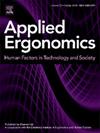基于实际应用场景的头戴式显示器面部压力敏感性评估
IF 3.4
2区 工程技术
Q2 ENGINEERING, INDUSTRIAL
引用次数: 0
摘要
随着虚拟现实和增强现实技术的发展,提高头戴式显示器(HMD)的舒适度对于优化用户体验至关重要。虽然压力阈值测量已广泛应用于可穿戴设备的设计,但还没有研究对 HMD 的压力敏感性进行专门调查。本研究开发了一种新型手持式电子测力计,用于测量 HMD 与面部之间九个关键接触点在不同作用力下的主观不适敏感度。采用重复测量方差分析对结果进行比较,并通过聚类对不适程度进行分类。根据这些分类创建了新的敏感度图。研究结果表明,眶周和颧骨区域的压力敏感度较高,随着压力的增加,性别差异也越来越明显。设计人员可以利用这些数据,在高敏感区域使用柔软或减压材料,并调整 HMD 的重量分布。本文章由计算机程序翻译,如有差异,请以英文原文为准。
Assessment of facial pressure sensitivity of head-mounted displays based on practical application scenarios
With the development of Virtual Reality and Augmented Reality technologies, improving the comfort of head-mounted displays (HMDs) is crucial for optimizing user experience. Although pressure threshold measurements have been widely applied in the design of wearable devices, no studies have yet investigated pressure sensitivity specific to HMDs. This study developed a novel handheld electronic force gauge to measure subjective discomfort sensitivity at nine key contact points between the HMD and the face under varying applied forces. Repeated measures ANOVA was used to compare the results, with discomfort levels classified through clustering. A new sensitivity map was created based on these classifications. The findings show higher pressure sensitivity around the periorbital and zygomatic regions, with gender differences becoming more pronounced as pressure increases. Designers can leverage these data to apply soft or pressure-relieving materials in highly sensitive areas and adjust the weight distribution of the HMD.
求助全文
通过发布文献求助,成功后即可免费获取论文全文。
去求助
来源期刊

Applied Ergonomics
工程技术-工程:工业
CiteScore
7.50
自引率
9.40%
发文量
248
审稿时长
53 days
期刊介绍:
Applied Ergonomics is aimed at ergonomists and all those interested in applying ergonomics/human factors in the design, planning and management of technical and social systems at work or leisure. Readership is truly international with subscribers in over 50 countries. Professionals for whom Applied Ergonomics is of interest include: ergonomists, designers, industrial engineers, health and safety specialists, systems engineers, design engineers, organizational psychologists, occupational health specialists and human-computer interaction specialists.
 求助内容:
求助内容: 应助结果提醒方式:
应助结果提醒方式:


